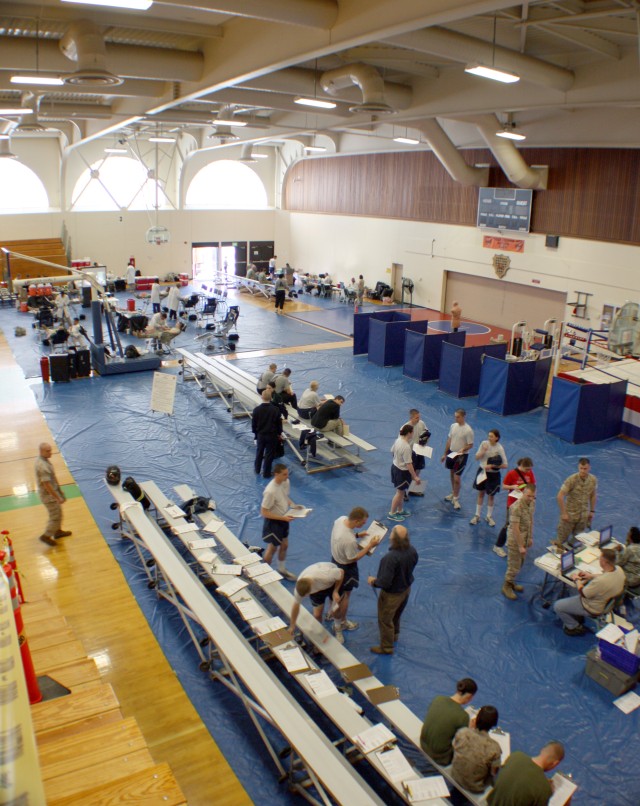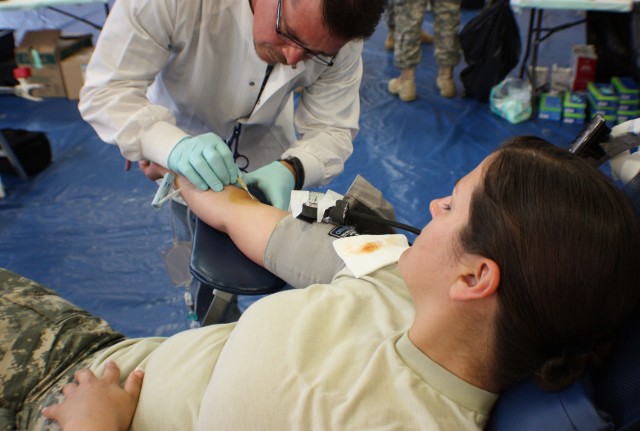JOINT BASE LEWIS-MCCHORD, Wash. - They are on a mission to save lives.
The blood team from Madigan Army Medical Center's Armed Services Blood Bank Center, Pacific Northwest recently conducted a blood drive at the Presidio of Monterey, Calif.
For the some donors, walking into the blood drive meant a chance to take a break from their daily routines.
Just a week later, for the recipient on the other side of the world, the donated pint of blood will mean the difference between life and death.
Blood donor recruiter and public affairs coordinator Victor Shermer said having folks step up to donate is vital to saving lives in Iraq and Afghanistan.
"What we have found is that without command emphasis, we don't get the donors to come in," Shermer said. "Our success is on the blood drives."
Just like its donors, the blood-collection team is made up of Soldiers, Airmen, Sailors and civilians who travel throughout the region - from California to Idaho - to facilitate blood drives and replenish fresh blood supplies.
The Armed Services Blood Bank Center at MAMC is currently the only military blood donor center in the Pacific Northwest and is supported by 18 donor centers across the region.
To save a life after traumatic injury, a wounded Soldier often requires 50 units of blood. An adult body contains 14 to 18 pints of blood.
Donor center technical supervisor Calvin Elkins said blood drives at installations like the Presidio offer a well of eligible donors.
"We're allowing Soldiers, Sailors and Airmen here the opportunity to help support those troops who are in theater right now by giving blood," Elkins said. "This is a really large blood drive for us."
Historically, the drive brings in more than 250 units of blood, he said.
"It's a very productive blood drive for us," Elkins said.
Blood drawn can be shipped in Iraq of Afghanistan within seven days, he said.
"It's a pretty quick turn around," Elkins said. "It could actually be in theater in less than a week."
Giving the "gift of life" is very important, he said.
"Very few people donate blood and there's always a need for it," Elkins said.
It's great to have young people come out to donate, he said.
"Hopefully, they will continue to do it for life," Elkins said.
Military life, with frequent deployments, changes of stations and other factors, makes the military population a particularly challenging one for donations, he said.
All Armed Services Blood Bank Center blood is mandated to be collected only from military installations. The blood team is also constrained by not being able to advertise for their drives.
"Our priority is making that quota for shipment into theater," Elkins said. The next priority is to support fluid needs at regional military hospitals.
Elkins and Shermer presented a donor appreciation award to Presidio of Monterey Commander Col. Sue Ann Sandusky during the blood drive March 22.
Sandusky said she was glad to support the drive and encouraged unit commanders to help spread the word.
Having donors show up is one challenge. Getting them through the jitters is yet another.
Civilian phlebotomist Frank Wake said he tries to make donors as comfortable as possible during the draw.
"I like to play with them, actually," Wake said. "When they tell me it's their first time, I like to tell them it's my first time, and when they're good and scared, I like to tell them, 'We'll both close our eyes.'''
Most people come back and tell Wake donating was easier than they thought it would be, he said.
"For the most part, it hurts worse to have your finger pricked," Wake said.
Making the act of giving blood meaningful for donors is also a priority, he said.
Some first-timers have more anxiety than others.
A series of yarns is an indicator that a donor might be close to passing out.
"That's the telltale sign - if they're yawning, they tend to be looking for a little air, and we pay close attention to that," Wake said.
Ultimately, the team collected 173 usable units of blood during the blood drive.
Precious cargo
Because time is of the essence when dealing with viable blood products, having air transportation available can shave a day off of blood turnaround.
The cold interior of the coolers housing boxes of blood can only protect its quality for so long before it has to be processed.
Members of the collection team left the Presidio of Monterey with four coolers and two specially designed boxes full of donations.
As blood team members drove onto the tarmac, the white fuselage of the sleek C-12 Huron reflected the orange glow of the setting sun.
The aircraft's pilot, Chief Warrant Officer 4 Jolly Harper, helped load the coolers and boxes of blood prior to takeoff.
"You have to make sure everything is strapped in and secure in case of turbulence," Harper said.
The stormy skies over Washington state sometimes provide a bumpy ride, he said.
Harper and other C-12 pilots have made several previous blood runs and know the critical nature of their mission.
"We're hauling precious cargo on (these) flights," Harper said.
Crossing over breaking waves and sandy beaches below, the Huron took to the air.
Once it reached its cruising altitude of 27,000 feet, the C-12 gave passengers and crew a smooth flight away from Monterey.
The 2-hour, 45-minute flight not only shaves time off of the trip but also reduces the blood-collection manpower that would normally be dedicated to driving the blood back to JBLM.
Elkins said that having the air assets available to them has made a positive difference in the blood center's ability to provide a better-quality product.
"Without those guys flying the C-12s and supporting us like they've supported us for a long time, we wouldn't be able to meet our mission," Elkins said.
The twin turboprop aircraft is capable of carrying passengers, cargo or variations of both.
Washington Regional Flight Center commander Capt. Rana Korynta said the continuing support of the blood run illustrates the capabilities of the C-12.
"We can take passengers and cargo straight to their destination," Korynta said.
The three C-12s, including an aircraft operated by the Washington National Guard Detachment 51, are capable of flying up to seven passengers from JBLM to most CONUS destinations, she said.
"We're here for the installation," Korynta said.
Korynta said the unit has transported various cargo, couriers, military and civilian personnel on official business.
Instructor Pilot Chief Warrant Officer 4 Darrell Bowen said the aircrews are ready to meet transportation needs.
"Weather permitting, and maintenance wise, we're up," Bowen said. "A standard day mission might take us down to San Diego and back."
Crews stay busy but C-12 pilots like to fly, he said. Bowen himself has logged more than 16,000 flight hours.
"We can support West to East Coast missions," Bowen said. "We can get about five hours flying time on one fuel load."
The Huron crews are eager to help support installation units through flying personnel and equipment, he said.
Flight Operations NCO Staff Sgt. Marla Darby said it's important to get the word out about what the unit can do and what services they offer.
"People should know we're here," Darby said. "Our flights don't cost their units money."
Rick Wood is a reporter with the Northwest Guardian, Joint Base Lewis-McChord's weekly newspaper.






Social Sharing